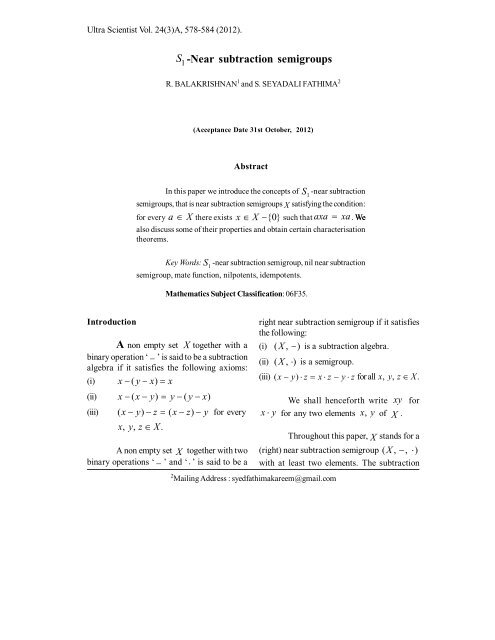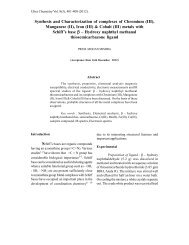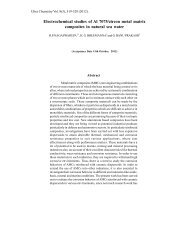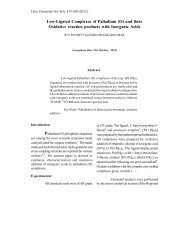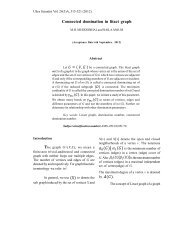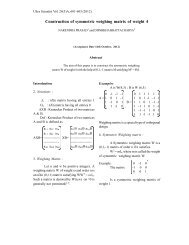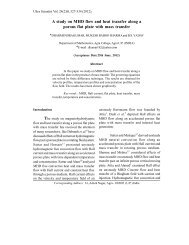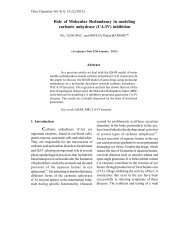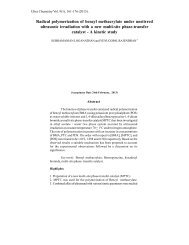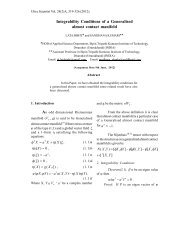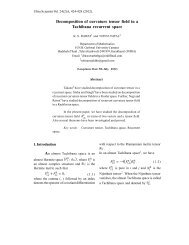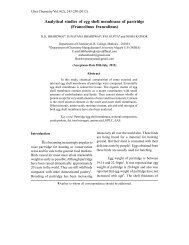S -Near subtraction semigroups - Ultrascientist.org
S -Near subtraction semigroups - Ultrascientist.org
S -Near subtraction semigroups - Ultrascientist.org
- No tags were found...
You also want an ePaper? Increase the reach of your titles
YUMPU automatically turns print PDFs into web optimized ePapers that Google loves.
Ultra Scientist Vol. 24(3)A, 578-584 (2012).S1-<strong>Near</strong> <strong>subtraction</strong> <strong>semigroups</strong>R. BALAKRISHNAN 1 and S. SEYADALI FATHIMA 2(Acceptance Date 31st October, 2012)AbstractIn this paper we introduce the concepts of S -near <strong>subtraction</strong>1<strong>semigroups</strong>, that is near <strong>subtraction</strong> <strong>semigroups</strong> X satisfying the condition:for every a X there exists x X {0}such that axa xa. Wealso discuss some of their properties and obtain certain characterisationtheorems.Key Words: S -near <strong>subtraction</strong> semigroup, nil near <strong>subtraction</strong>1semigroup, mate function, nilpotents, idempotents.Mathematics Subject Classification: 06F35.IntroductionA non empty set X together with abinary operation ‘ ’ is said to be a <strong>subtraction</strong>algebra if it satisfies the following axioms:(i) x ( y x) x(ii) x ( x y) y ( y x)(iii)( x y) z ( x z) y for everyx, y,z X.A non empty set X together with twobinary operations ‘ ’ and ‘ ’ is said to be a2 Mailing Address : syedfathimakareem@gmail.comright near <strong>subtraction</strong> semigroup if it satisfiesthe following:(i) ( X , )is a <strong>subtraction</strong> algebra.(ii) ( X , )is a semigroup.(iii) ( x y) z x z y z for all x, y,z X.We shall henceforth write xy forx y for any two elements x, y of X .Throughout this paper, X stands for a(right) near <strong>subtraction</strong> semigroup ( X , ,)with at least two elements. The <strong>subtraction</strong>
R. Balakrishnan, et al. 579determines an order relation on X : a b a b 0 where 0 a a is an element thatdoes not depend on the choice ofa X . InX , 0 x 0 and 0x 0 for all x X . Ifx 0 0 for all x X , we say X is zerosymmetric.We recall the following definitionsfrom 6 : A near <strong>subtraction</strong> semigroup X is saidto have (i) IFP (Insertion of Factors Property)if for a, b in X , ab 0 axb 0 for allx X (ii) (*, IFP)if X has IFP andab 0 ba 0 for a, b X (iii) StrongIFP if for all ideals I of X , ab Ifor all x in X . IfAB { ab / a A,b B}. axb IA, B X , thenWe say that subset Y of X which isclosed under ‘ ’ and XY Y is called anX -system and if in addition, YX Y thenY is called an invariant X -system 1-3 .such thatIf there exists a mapf:Xa a f ( a)a for all a in X thenf is called a mate function for X . We say thatX is an S (S')near <strong>subtraction</strong> semigroup ifa Xa (aX ) for all a X .2. Notation :a) An element e XXis said to be (i) idem-2 kpotent if e e (ii) nilpotent if e 0for some positive integer k ( X is said tobe nil if every element of X is nilpotent)(iii) right identity if ea a for every a X .2b) If a 0 a 0 for all a X , thenX has no non zero nilpotent elements (asin problem 14, p.9 of 4 ).c) { n X / n(x y) nx ny, forX dall x, y X }-the set of all distributiveelements of X .d) The centre of X is defined as C(X ) { a X / ax xa for all x X}.e) E denotes the set of all idempotentsof X .f) L denotes the set of all nilpotent elementsof X .*g) X X {0}.For definitions and notations used butleft undefined in this paper we refer to Pilz 5 .3. S -<strong>Near</strong> Subtraction Semigroup :1Let us begin with the followingdefinition:Definition 3.1: We say that X is anS -near <strong>subtraction</strong> semigroup if for every1a X there existsaxa xa.*x X such thatExamples 3.2 (a) Let X { 0, a,b,1}in which ‘ ’ and ‘ ’ are defined by
580 S1-<strong>Near</strong> <strong>subtraction</strong> <strong>semigroups</strong>. 0 a b 10 0 0 0 0a a 0 a 0b b b 0 01 1 b a 0 0 a b 10 0 0 0 0a 0 a 0 ab 0 0 b b1 0 a b 1This is an S 1 -near <strong>subtraction</strong> semigroup.(b) We consider the near <strong>subtraction</strong> semigroup(X,-,.)where X { 0, a,b,1}, ‘’ and ‘ . ’ aredefined by 0 a b 10 0 0 0 0a a 0 1 bb b 0 0 b1 1 0 1 0 0 a b 10 0 0 0 0a a a a ab a 0 1 b1 0 a b 1This is not an S 1 -near <strong>subtraction</strong>semigroup.We shall now prove a characterisationof S 1 -near <strong>subtraction</strong> <strong>semigroups</strong>.Theorem 3.3 : Let X be a nil near<strong>subtraction</strong> semigroup. Then X is an S 1 -near<strong>subtraction</strong> semigroup if and only if X is zerosymmetric.a XProof: For the only if part, we take. Since X is an S 1 -near <strong>subtraction</strong>*semigroup there exists x X such that,axa xa(1)We shall prove thatk kax a x a(2)for all positive integers k. Equation (1) demandsthat (2) is true for k=1. We assume that theresult is true for k s 1. If k = s thens s1s1ax a ax ( xa) ax axa (by [1]) =(ax s 1a)xa (x s 1 a)xa x s1 ( axa)=xs1( xa)xsa. Thus by induction ax k ax k a for all positive integers k. Since X is nil,tx 0 for some positive integer t and sinceax t a = x t a we get a0a 0a.It followsthat X is zero symmetric.For the if part, let a X . Since X isnil, there exists a positive integer k > 1 suchkthat a 0 . This implies xa 0 wherex ak 1 . Therefore a(xa)axa = a0 0(since X is zero-symmetric) = xa. Thus X isan S 1 near <strong>subtraction</strong> semigroup.Proposition 3.4 : Let X be a zerosymmetric S 1 -near <strong>subtraction</strong> semigroup. IfX has no non-zero zero-divisors then every X-system and every ideal of X is an S 1 -near<strong>subtraction</strong> semigroup in its own right.Proof: Let A be an X-system of X and**A A{0}. Let a A . Since X is an S 1 -near
R. Balakrishnan, et al. 581*<strong>subtraction</strong> semigroup there exists x Xsuch that axa xa . We take n xa XA.Since A is an X-system of X, n A.Since X hasno non-zero zero-divisors, n 0 . Nowana a(xa)a = ( axa)a ( xa)a na . Ifa 0 then, since X is zero symmetric,*ana na for any n A . Thus A is an S 1 -near <strong>subtraction</strong> semigroup.Next, let I be an ideal of X and let*a I. If a 0 then ana na for any n I .Suppose a 0. Since X is an S 1 -near <strong>subtraction</strong>semigroup, there exists*x X such thataxa xa. If i ax IX , since I is an idealof X we get i I.Our hypothesis demands that i 0.Now aia a( ax)a a(axa) a(xa) ( ax)a ia . Thus I is an S 1 -near <strong>subtraction</strong>semigroup.We furnish below a necessary andsufficient condition for an S 1 -near <strong>subtraction</strong>semigroup to have a mate function.Proposition 3.5: Let X be an S 1 -near<strong>subtraction</strong> semigroup without non-zero zerodivisors.Then X has a mate function if andonly if X is Boolean.Proof: Let a X . Since X is an S 1 -near <strong>subtraction</strong> semigroup there exists*x X such that axa xa .For the ‘only if ’ part, we assume that,X has a mate function ‘f ’. Then a af ( a)a .We have, af ( a)xa= af ( a)(xa)= af ( a)(axa) af ( a)a(xa)= axa . That is, af ( a)xa axa and this implies af ( a)xa axa 0 ( af ( a) a)xa 0. Since X has no non-zerozero-divisors, af ( a) a 0. That is af ( a) a.2Therefore ( af ( a))a a . This implies that2a a . Consequently X is Boolean.Proof of ‘if ’ part is obvious.4. S 1 -near <strong>subtraction</strong> semigroup and thesubsets:In this section we introduce thenotation X S( a)8 , a X and discuss the1properties of S 1 -near <strong>subtraction</strong> semigroupwith the subset X S( ) .1aNotation 4.1: For any a X, we*denote { x X / axa xa}by X S( ) .1aProposition 4.2: It easily followsthat X is an S 1 -near <strong>subtraction</strong> semigroup ifand only ifX S( a) for all a X .1Proof: Straight forward.Example 4.3 (a) We consider the S 1 -near <strong>subtraction</strong> semigroup X cited in Example3.2(a). We observe thatX S 1( a) for all
582 S1-<strong>Near</strong> <strong>subtraction</strong> <strong>semigroups</strong>.a X.(b) In the case of Example 3.2(b),X S( b) .1Proposition 4.4: Let X be an S 1 -near<strong>subtraction</strong> semigroup. If ab=ba for a,b Xand ifXSa) XS( ) then X S1( a)( b1 1 XS( b) X ( ab)1 S .1Proof: Let a, b X.Suppose ab ba.Let x X ( a) X ( b)then x X( a)S1S1and x X ( b)i.e., axa xa and bxbS1 xb . Now ( ab)x(ab) ( ba)x(ab)= b( axa)b b( xa)b bx(ab)=bx(ba)= ( bxb) a = ( xb) a =x (ba) = x (ab).S1It follows that x X ( ab)andS1hence X ( a) X ( b) X ( ab).S1S1S1Lemma 4.5: Let X be an S 1 -near<strong>subtraction</strong> semigroup. Then X S( ) has no1anon-zero zero-divisors if and only if ( a)is a multiplicative system.X S 1Proof: Since X is an S 1 -near <strong>subtraction</strong>semigroup,X S( a) for all a X1(by Propsoition 4.2). For the ‘only if ’ part, let*x, y X ( a). Then x, y X and axa 1xa ,Saya ya . It follows that a ( xy)a =ax ( ya) = ax (aya)= ( axa) ya= ( xa) ya= x(aya)= x ( ya)= ( xy) a . That is a ( xy)a ( xy)a.Further since X S( ) has no non-zero zero1adivisors, xy 0. Consequently, xy X ( )and X S( ) is a multiplicative system.1aS1aFor the ‘if ’ part, let x, y X ( a).!Since X S( a)is a multiplicative system1*xy XS( a). As X ( a)X1 S , it followsthat xy 0 and hence X S( a)has no nonzerozero-divisors.We conclude our discussion withtheorems 4.7 where we prove some importantproperties of an S 1 -near <strong>subtraction</strong> semigroup.Before that we have:1Lemma 4.6 : If X is an S 1 -near subtract-ktion semigroup then X S( a) X ( a ) for all11S1positive integers k > 1 and for all a X .Proof: Let x X ( ) axa xa.S1a2 2Therefore a xa a(axa)a= a ( xa)x= (axa) a= ( xa) a =2xa . That isa 2 xa 2 =Continuing in the same vein we get,S2xa .k ka xa =kxa for all positive integer k. It follows thatkX a) X ( a ) .S(1S1Theorem 4.7: Let X be an S 1 -near<strong>subtraction</strong> semigroup, without non-zero zero
R. Balakrishnan, et al. 583divisors. Then we have the following:*(i) aXSa) XS( ) for all a X .( a1 1*(ii) XS( a)a XS( a)for all a X .1(iii) If X is finite then*for all a X .1X S( a)a1X S 1(iv) If X is zero symmetric then ( a)XX S( ) for all a X .1aX S 1( a)kk(v) X ( a)] X ( a ) for all positive[S1S1integers k > 1 and for all a X .*Proof: (i) Let z aX ( a). Then thereexists x X ( a)such that z ax . SinceS1x X ( a),axa xa. Now aza= a ( ax)aS1= a (axa)= a (xa)= ( ax) a = za . Since X has*no non-zero zero-divisors, z X . It followsS!that z X ( ) and therefore 7S1aaXSa) XS( )(3)( a1 1Let y X ( a). Then aya ya .S1That is ( ay y)a 0 . Since X has no nonzerozero-divisors, ay y 0. This impliesy ay aX ( a)and thereforeS1X S1( a).XSa) aXS( )(4)( a1 1From (3) and (4) we get aX S( ) 1a(ii) If z X ( a)then aza za . ClearlyS1then a ( za)a= ( aza) a= ( za) a. That is a ( za)a= ( za) a . Since X has no non-zero divisorsza 0 . Consequently, za X ( a)XS1( a)a XS1( a).S1(iii) Suppose X is a finite S 1 -near <strong>subtraction</strong>semigroup. Letx , x , 2,x1sbe all theelements of ( ) . From (ii) we getX S1ax a , 1x2a, ... , ( )*xsa XSa for all a X .1We prove that they all are distinct. Supposexka xlafor k l . Then ( xk xl) a 0.Since X has no non-zero divisors we getx k x l 0 . That is xk xlwhich is acontradiction tok l . Therefore x a , 1x2a,... , x sa are s-distinct elements lying inX S( a). Thus every element y X ( a)1can be written asS1y x a for some x t inX S( a).Therefore X ( a)1S X a a1S( ) and1by using (ii) we gettX S( a)a = X ( a)1 S .1(iv) We observe that X is zero-symmetric sinceit is an S 1 -near <strong>subtraction</strong> semigroup by Theorem
584 Ultra Scientist Vol.24(3)A, (2012).*3.3. For any a, n X , x X ( a)axa xa ( ax x)a 0. Since X has nonon-zero zero-divisors, ax x 0. ThereforeS1( ax x)na 0na 0. This implies thataxna xna 0. That is a( xn)a ( xn)a.Since X has no non-zero zero-divisors,xn 0. Therefore xn X ( a)and thisimpliesS1*X S( a)X X ( a).1S 1 If a 0 , then0(xn)0 ( xn)0(since X is zero-symmetric.Consequentlya X .*X S( a)X ( a)11X S for all(v) Since X has non-zero zero divisors, X S1( a)has no non-zero zero divisors for all a X .Now Lemma 4.5 demands that X S( ) is a1amultiplicative system. That is xy X ( a)for all x,y X ( a).Therefore ( a)]S1 X S1( a).Proceeding this way,[ a1 1[ X S 1S1kXS( a)] XS( ) (5)for all positive integers k > 1. Appealing toLemma 4.6 we get.2[ XS1( a)]kX ( a) X ( a ) (6)S1S1Comibining (5) and (6) we getkReferencesXS1( ak).1. P. Dheena and G. Satheesh Kumar, OnStrongly regular near <strong>subtraction</strong> <strong>semigroups</strong>,Common Korean Math. Soc., 22, 323-330(2007).2. P. Dheena and G. Satheesh Kumar, Weaklyprime left ideals in near <strong>subtraction</strong><strong>semigroups</strong>, Common Korean Math. Soc..,23, 325-331 (2008).3. Von Neumann, J., On regular ring, Proc.Nat. Acad. USA, 22, 707-713 (1936).4. N.H. McCoy, The theory of rings, MacMillan and Co., (1970).5. Pilz Gunter, <strong>Near</strong>-Rings, North Holland(1983).6. S. Seyadali Fathima and R. Balakrishnan,Mate Functions in near <strong>subtraction</strong> <strong>semigroups</strong>,To appear in MathematicsEducation, Vol. XLVII, No. 2, June 2013,Bihar, India.7. S. Seyadali Fathima and R. Balakrishnan,K(r,m) near <strong>subtraction</strong> <strong>semigroups</strong>,International Journal of Algebra, Vol. 5,No. 17, 827-834 (2011).8. S. Silviya, R. Balakrishnan and T. TamilzhChelvam, S 1 near-rings, MathematicsEducation, Vol. XLVI, No. 3, (2012).


